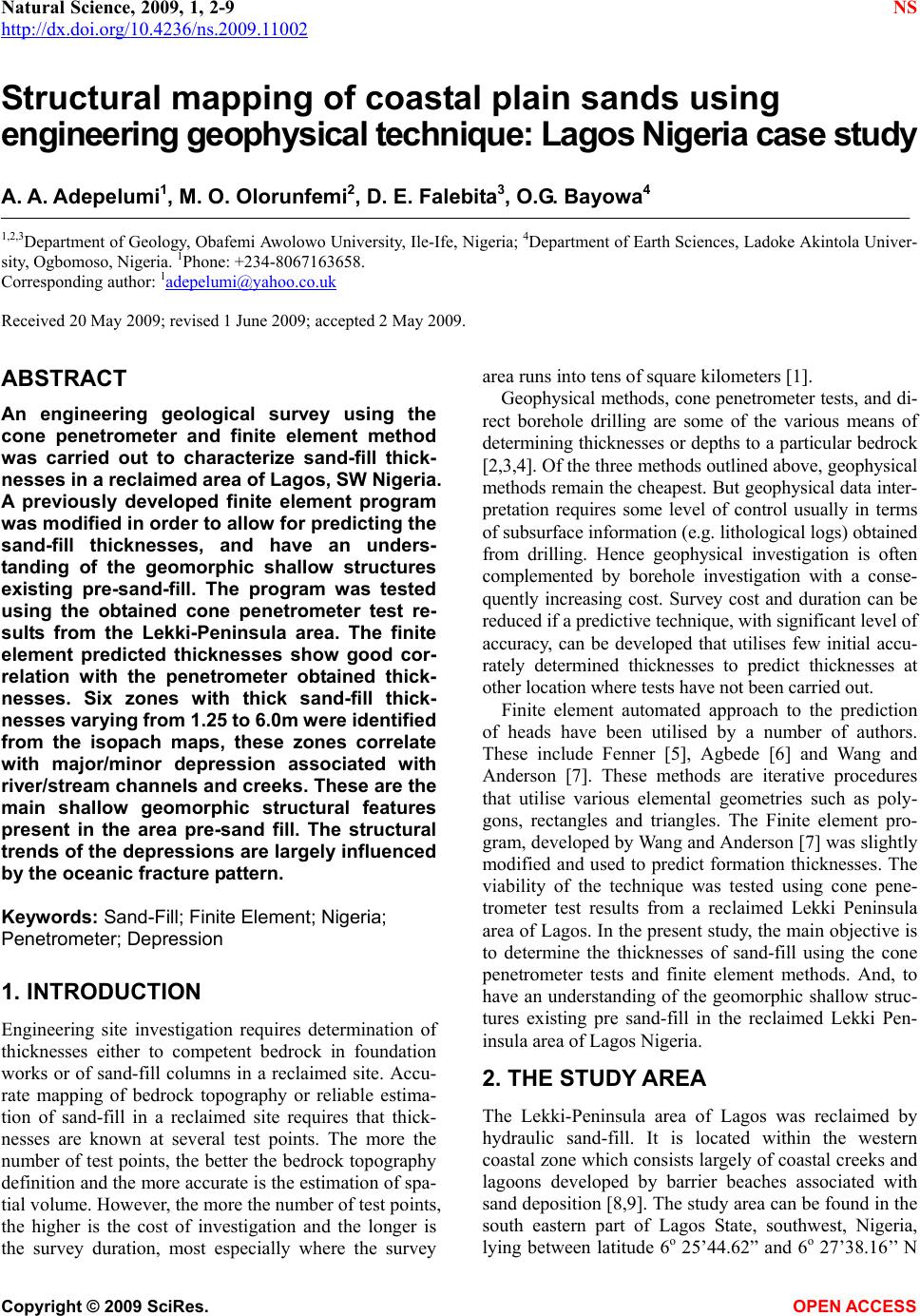
Natural Science, 2009, 1, 2-9 NS
http://dx.doi.org/10.4236/ns.2009.11002
Copyright © 2009 SciRes. OPEN ACCESS
Structural mapping of coastal plain sands using
engineering geophysical technique: Lagos Nigeria case study
A. A. Adepelumi1, M. O. Olorunfemi2, D. E. Falebita3, O.G. Bayowa4
1,2,3Department of Geology, Obafemi Awolowo University, Ile-Ife, Nigeria; 4Department of Earth Sciences, Ladoke Akintola Univer-
sity, Ogbomoso, Nigeria. 1Phone: +234-8067163658.
Corresponding author: 1adepelumi@yahoo.co.uk
Received 20 May 2009; revised 1 June 2009; accepted 2 May 2009.
ABSTRACT
An engineering geological survey using the
cone penetrometer and finite element method
was carried out to characterize sand-fill thick-
nesses in a reclaimed area of Lagos, SW Nigeria.
A previously developed finite element program
was modified in order to allow for predicting the
sand-fill thicknesses, and have an unders-
tanding of the geomorphic shallow structures
existing pre-sand-fill. The program was tested
using the obtained cone penetrometer test re-
sults from the Lekki-Peninsula area. The finite
element predicted thicknesses show good cor-
relation with the penetrometer obtained thick-
nesses. Six zones with thick sand-fill thick-
nesses varying from 1.25 to 6.0m were identified
from the isopach maps, these zones correlate
with major/minor depression associated with
river/stream channels and creeks. These are the
main shallow geomorphic structural features
present in the area pre-sand fill. The structural
trends of the depressions are largely influenced
by the oceanic fracture pattern.
Keywords: Sand-Fill; Finite Element; Nigeria;
Penetrometer; Depression
1. INTRODUCTION
Engineering site investigation requires determination of
thicknesses either to competent bedrock in foundation
works or of sand-fill columns in a reclaimed site. Accu-
rate mapping of bedrock topography or reliable estima-
tion of sand-fill in a reclaimed site requires that thick-
nesses are known at several test points. The more the
number of test points, the better the bedrock topography
definition and the more accurate is the estimation of spa-
tial volume. However, the more the number of test points,
the higher is the cost of investigation and the longer is
the survey duration, most especially where the survey
area runs into tens of square kilometers [1].
Geophysical methods, cone penetrometer tests, and di-
rect borehole drilling are some of the various means of
determining thicknesses or depths to a particular bedrock
[2,3,4]. Of the three methods outlined above, geophysical
methods remain the cheapest. But geophysical data inter-
pretation requires some level of control usually in terms
of subsurface information (e.g. lithological logs) obtained
from drilling. Hence geophysical investigation is often
complemented by borehole investigation with a conse-
quently increasing cost. Survey cost and duration can be
reduced if a predictive technique, with significant level of
accuracy, can be developed that utilises few initial accu-
rately determined thicknesses to predict thicknesses at
other location where tests have not been carried out.
Finite element automated approach to the prediction
of heads have been utilised by a number of authors.
These include Fenner [5], Agbede [6] and Wang and
Anderson [7]. These methods are iterative procedures
that utilise various elemental geometries such as poly-
gons, rectangles and triangles. The Finite element pro-
gram, developed by Wang and Anderson [7] was slightly
modified and used to predict formation thicknesses. The
viability of the technique was tested using cone pene-
trometer test results from a reclaimed Lekki Peninsula
area of Lagos. In the present study, the main objective is
to determine the thicknesses of sand-fill using the cone
penetrometer tests and finite element methods. And, to
have an understanding of the geomorphic shallow struc-
tures existing pre sand-fill in the reclaimed Lekki Pen-
insula area of Lagos Nigeria.
2. THE STUDY AREA
The Lekki-Peninsula area of Lagos was reclaimed by
hydraulic sand-fill. It is located within the western
coastal zone which consists largely of coastal creeks and
lagoons developed by barrier beaches associated with
sand deposition [8,9]. The study area can be found in the
south eastern part of Lagos State, southwest, Nigeria,
lying between latitude 6o 25’44.62” and 6o 27’38.16’’ N